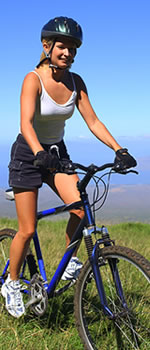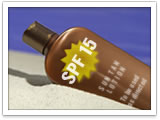
|
Follow Me On: |
 |
Kathleen Petty AVP/Sr Mortgage Originator Global Credit Union Home Loans AK#157293 Phone: (907)261-3458 Cell: 223-4440 Fax: (907)929-6699 License: NMLS Unique Identifier #203077 K.Petty@gcuhome.com https://www.globalcu.org/home-loans/resources/originators/Kathleen-Petty/ |
 | ||
| ||||
June 2006

|
Protecting Yourself From the Sun Tips for a Safe & Happy Summer
Not only is a "golden tan" the objective of every sun worshiper, it's also frequently perceived as a visual indicator of one's overall health. In terms of medical reality, however, these sentiments are quite alarming; especially when you consider their potential ramifications. The Facts
According to the Centers for Disease Control, exposure to UV rays is the most important factor when it comes to developing skin cancer. In the United States, skin cancer has been on the rise for the last 25 years. It's increasing at a rate of 3% a year, and there are over 1 million cases annually. Malignant melanoma, the most serious of skin cancers, is also the most common type of cancer for people between the ages of 25-29. Skin cancer is curable if caught early. If left unattended, it can spread to other organs, most commonly the lungs and the liver. UV rays from the sun are most intense between the hours of 10am and 4pm, and are at their maximum between 12pm and 1pm. UV rays are also more harmful during the summer as heat intensifies their effects. Higher altitudes also influence UV rays, as radiation levels increase 4-5% every 1,000 feet above sea level. High winds, as well as the reflection off of water and snow, also add to their intensity. The Fix
First of all, it's imperative that you invest in a quality sunscreen. The best brands contain a UVA blocking ingredient known as either avobenzone or Parsol 1789. Look for products with an SPF of at least 15 for the body and 30 for the face. (If you have children, be sure to confirm that the sunscreen you purchase is suitable for their ages.) The bottom line is the more SPF the better, especially for fair-skinned people. SPF, which stands for Sun Protection Factor, is determined by exposing human subjects to an indoor light that mimics the noontime sun. The number (e.g. 15 or 30) stands for the amount of time sunburn is delayed. If you were going to burn in 10 minutes on a given day, and apply sunscreen rated SPF 15, sunburn should not occur for 150 minutes. It's important to apply sunscreen 20 minutes before heading out into the sun to allow time for absorption. It is equally important to reapply every two hours or even more frequently if you are swimming or partaking in strenuous activities. When applying sunscreen, make sure you completely cover your body and face. Areas that are commonly overlooked include the belly button, under the waste band/straps of a swimsuit, the ears, and the lips. Hats, sunglasses, and protective summer-weight clothing are also a must. For headwear, wide-brimmed hats work much better than baseball caps. When it comes to sunglasses, be sure you purchase ones that have UV protection. Exposure to UV rays has been linked to everything from cataracts to skin cancer of the eyelids. As for clothing, a long-sleeve cotton shirt, loose pants which cover the entire leg, and footwear are optimal. If you decide to spend your day in the sun, make sure you take periodic breaks, especially at midday or lunch. Seeking refuge in the shade for 5 to 10 minutes every hour helps to maintain skin temperature. And whatever you decide to do yourself, do not bring an infant into the sun. Infants under six months should not wear sunscreen at all, which makes them even more susceptible to sun damage. Treating Sun Damage
If, within that time, the skin blisters or the sunburn is accompanied by fever, chills, vomiting, or confusion, see a doctor right away. If it simply hurts, here's the game plan: Start by taking a cool bath mixed with 1/2 cup of baking soda. Do not use any soap or first-aid anesthetic products containing benzocaine as they can cause irritation and allergic reactions. After a bath, there are several creams which will bring comfort as well as repair the damage. Any lotions containing aloe or calendula (the purer the better) are sure to help with the pain. The best ones are usually found at health food stores. To reduce swelling, utilize an over-the-counter 1% hydrocortisone cream or a vitamin E cream. Avoid using petroleum jelly or any greasy ointments as they have a tendency to trap heat. Taking the recommended dosage of ibuprofen will not only relieve some of the pain, it will also help with swelling. Taking extra vitamin C will help to speed the healing process as well. One last tip for the sunburned, wear your pajamas inside out to avoid irritation from the seams when sleeping. Final Thoughts on Skin
| |||||||||||||||||||||
License #AK157293 You are receiving a complimentary subscription to YOU Magazine as a result of your ongoing business relationship with Kathleen Petty. While beneficial to a wide audience, this information is also commercial in nature and it may contain advertising materials. INVITE A FRIEND to receive YOU Magazine. Please feel free to invite your friends and colleagues to subscribe. SUBSCRIBE to YOU Magazine. If you received this message from a friend, you can subscribe online. UNSUBSCRIBE: If you would like to stop receiving emails from Kathleen Petty, you can easily unsubscribe. Global Credit Union Home Loans AK#157293 |
, 125 W Dimond Blvd #110 Anchorage, AK 99515 Powered by Platinum Marketing © Copyright 2024. Vantage Production, LLC. | |||||||||


